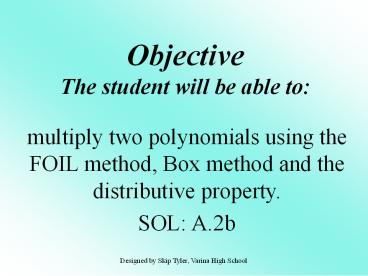Multiply%20Polynomials - PowerPoint PPT Presentation
Title:
Multiply%20Polynomials
Description:
multiply two polynomials using the FOIL method, Box method and the distributive property. ... It is an acronym and tells you which terms to multiply. ... – PowerPoint PPT presentation
Number of Views:732
Avg rating:3.0/5.0
Title: Multiply%20Polynomials
1
ObjectiveThe student will be able to
multiply two polynomials using the FOIL method,
Box method and the distributive property. SOL
A.2b
Designed by Skip Tyler, Varina High School
2
There are three techniques you can use for
multiplying polynomials.
- The best part about it is that they are all the
same! Huh? Whaddaya mean? - Its all about how you write itHere they are!
- Distributive Property
- FOIL
- Box Method
- Sit back, relax (but make sure to write this
down), and Ill show ya!
3
1) Multiply. (2x 3)(5x 8)
- Using the distributive property, multiply 2x(5x
8) 3(5x 8). - 10x2 16x 15x 24
- Combine like terms.
- 10x2 31x 24
- A shortcut of the distributive property is called
the FOIL method.
4
The FOIL method is ONLY used when you multiply 2
binomials. It is an acronym and tells you which
terms to multiply. 2) Use the FOIL method to
multiply the following binomials(y 3)(y 7).
5
(y 3)(y 7). F tells you to multiply the
FIRST terms of each binomial.
- y2
6
(y 3)(y 7). O tells you to multiply the
OUTER terms of each binomial.
- y2 7y
7
(y 3)(y 7). I tells you to multiply the
INNER terms of each binomial.
- y2 7y 3y
8
(y 3)(y 7). L tells you to multiply the
LAST terms of each binomial.
- y2 7y 3y 21
- Combine like terms.
- y2 10y 21
9
Remember, FOIL reminds you to multiply the
- First terms
- Outer terms
- Inner terms
- Last terms
10
The third method is the Box Method. This method
works for every problem!
- Heres how you do it. Multiply (3x 5)(5x 2)
- Draw a box. Write a polynomial on the top and
side of a box. It does not matter which goes
where. - This will be modeled in the next problem along
with FOIL.
3x -5
5x
2
11
3) Multiply (3x - 5)(5x 2)
15x2
- First terms
- Outer terms
- Inner terms
- Last terms
- Combine like terms.
- 15x2 - 19x 10
3x -5
5x
2
6x
-25x
15x2
-25x
-10
6x
-10
You have 3 techniques. Pick the one you like the
best!
12
4) Multiply (7p - 2)(3p - 4)
21p2
- First terms
- Outer terms
- Inner terms
- Last terms
- Combine like terms.
- 21p2 34p 8
7p -2
3p
-4
-28p
-6p
21p2
-6p
8
-28p
8
13
Multiply (y 4)(y 3)
- y2 y 12
- y2 y 12
- y2 7y 12
- y2 7y 12
- y2 y 12
- y2 y 12
- y2 7y 12
- y2 7y 12
14
Multiply (2a 3b)(2a 4b)
- 4a2 14ab 12b2
- 4a2 14ab 12b2
- 4a2 8ab 6ba 12b2
- 4a2 2ab 12b2
- 4a2 2ab 12b2
15
5) Multiply (2x - 5)(x2 - 5x 4)
- You cannot use FOIL because they are not BOTH
binomials. You must use the distributive
property. - 2x(x2 - 5x 4) - 5(x2 - 5x 4)
- 2x3 - 10x2 8x - 5x2 25x - 20
- Group and combine like terms.
- 2x3 - 10x2 - 5x2 8x 25x - 20
- 2x3 - 15x2 33x - 20
16
5) Multiply (2x - 5)(x2 - 5x 4) You cannot
use FOIL because they are not BOTH binomials.
You must use the distributive property or box
method.
x2 -5x 4
2x
-5
2x3
-10x2
8x
Almost done! Go to the next slide!
-5x2
25x
-20
17
5) Multiply (2x - 5)(x2 - 5x 4) Combine like
terms!
x2 -5x 4
2x
-5
2x3
-10x2
8x
-5x2
25x
-20
2x3 15x2 33x - 20
18
Multiply (2p 1)(p2 3p 4)
- 2p3 2p3 p 4
- y2 y 12
- y2 7y 12
- y2 7y 12

